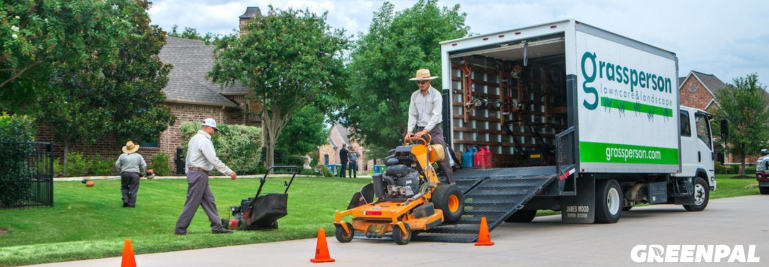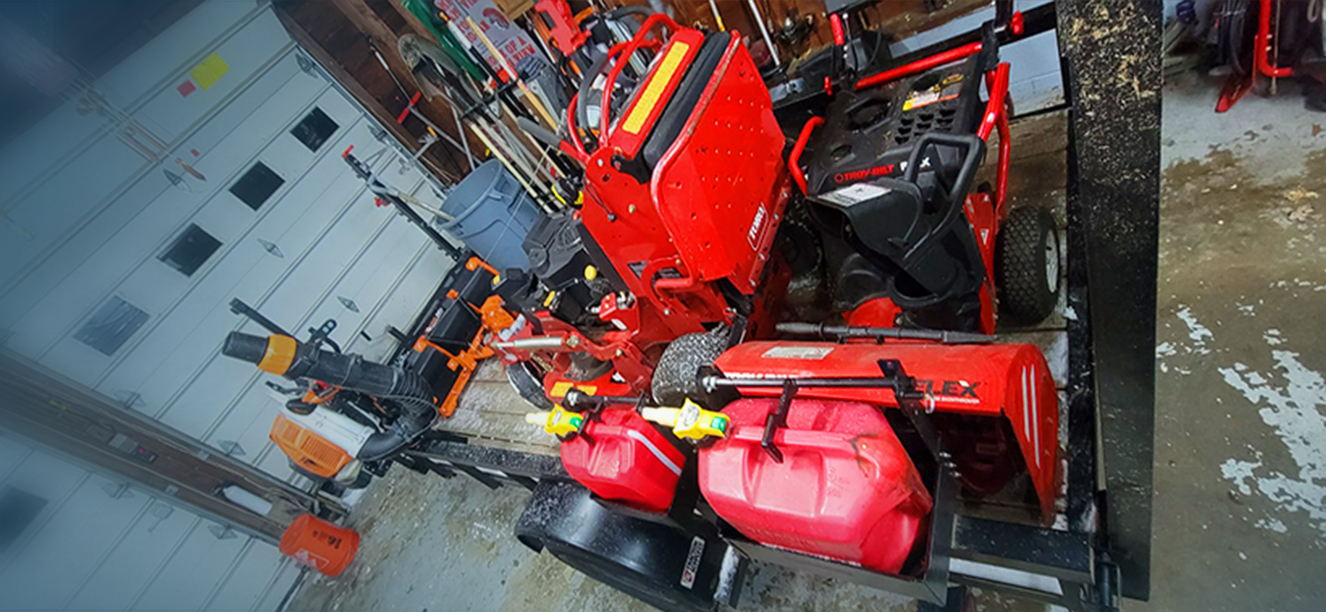Part of mastering a perfectly manicured lawn is using a pre-emergent before the weeds show up.
So which pre-emergent is the best to use?
And which type of pre-emergents should you be carrying on your truck?
Well, we have done a deep dive, and this is what we found about using pre-emergents effectively.
Be warned! The answer isn't just what product is the best; it is also when to apply it for optimal results.
But we will cover all of that and more...
Let's dive in!
.png)
Why Pre-Emergents Are So Important
Proper use of pre-emergents can help you make a pristine lush green lawn by getting rid of weeds before they emerge.
For example, if you have a client with a Kentucky Bluegrass lawn, and you want to stop encroaching weeds like crabgrass.
You can apply a pre-emergent to kill them before they ever show up!
How Pre-Emergents Work
Pre-emergents work in 3 different ways, they can inhibit:
Plant root growth
Seed cell division
Or specific enzymes from developing.
Unlike a weed-killer like Roundup, pre-emergents don't kill fully grown grasses. Instead, they work by targeting the seeds of weeds, by inhibiting root growth. Therefore, they can be sprayed on a fully grown lawn, and on a wide variety of grass types.
However, because many pre-emergents impact root growth, they may kill newly seeded lawns.
For Best Results; Adopt a 2-Step Process
Most pre-emergents have a yearly maximum which you can apply to a lawn. So using a mixture of 2 different products can help you work around that limit. And help you get better results.
While two applications may be more expensive than one, doing so will help you effectively fight off weeds, even crabgrass!
Step #1: Prodiamine- Barricade
Prodiamine based pre-emergents, such as Barricade, are easily the most preferred pre-emergents among lawn care professionals.
Here's the deal, while using both Prodiomine and Dithiopyr in a 2-step process is best. If you have to choose one as a lawn care professional, Prodiamine is the go-to.
Pros of Prodiamine:
From a lawn care professional's perspective, Prodiamine-based pre-emergents are a go-to. While Prodiamine is thicker and more likely to gum up equipment, it will stay on the ground longer. Furthermore, it can be applied earlier in the season.
.png)
Step #2: Dithiopyr- Dimension
Is it too late in the season to apply Prodiamine? No worries, that's what Dithiopyr is for. Get this Dithiopyr can come in the clutch and kill crabgrass up to the 3-leaf stage.
This late-stage action makes it a great product to use later in the season, as long as you get it down before the warmer weather. This characteristic of Dithiopyr, commonly known as Dimension, also makes it an excellent choice for a second application of pre-emergent.
Pros of Dithiopyr:
Dithiopyr is easier to apply because it is not as thick; furthermore, it will kill weeds, predominantly crabgrass, in later stages than Prodiamine can.
These benefits make it a better option for homeowners looking to keep things simple and only use one product.
Apply Pre-emergents In Optimal Weather
The best time to begin to apply a pre-emergent is before the ground temperature is above 55 degrees. However, you want to avoid applying a pre-emergent when temperatures rise above 90 degrees.
Here's the deal, microbes will quickly break pre-emergent products down. And because these microbes become more active in the warmer weather, pre-emergents will break down too fast in warmer weather to be effective.
Furthermore, most weeds have already begun to emerge by the time the temperatures are that high. So they won't really be effective at that stage anyhow. When applying a pre-emergent, don't forget to pick a good granular fertilizer for the lawn.
Pre-Emergent Comparison
| Feature | Prodiamine (Barricade) | Dithiopyr (Dimension) |
|---|---|---|
| Application Timing | Early season | Late season before the 3-leaf stage of crabgrass |
| Main Benefit | Longer-lasting, can be applied earlier | Kills crabgrass up to the 3-leaf stage |
| Consistency | Thicker, may gum up equipment | Easier to apply due to thinner consistency |
| Best Used For | First application in a two-step process | Second application or late-season application |
| Application Temperature | Before ground temperature is above 55 degrees | Before warmer weather, avoid applying above 90 degrees |
When to Apply Pre-emergents in the North
In the North, you will likely want to apply Prodiomine around the time that the magnolias or crab apples are blooming, in the early spring.
Then, especially if you have a big issue with crabgrass on the lawn. You will want to consider a second application of Dithiopyr just before summer in mid-May. This will allow you to get a second application in before the warmer weather.
When to Apply Pre-emergents in the South
In the South, you will want to begin applying your first pre-emergent as early as mid-February. Again, the first application should be a Prodiamine based product.
For the second, Dithiopyr-based pre-emergent, you will want to apply that somewhere in mid-May. Right before the warm summer weather rolls on in!
Pro-tip! Pre-emergents only kill what has yet to emerge and will not kill a weed that is already established.
.png)
Poll: Prefered Crabgrass preventative of GreenPal Pros
The main aim of pre-emergents is to kill crabgrass before it grows, but with so many lawn care companies. Each one will adopt a strategy of their own.
Our poll shows that 46% of our lawn care pros prefer to use, High-Yield a Dithiopyr-based pre-emergent, making it the most popular crabgrass prevention product among GreenPal Pros.
The second choice for crabgrass prevention among GreenPal Pros is a tie, at 18%, between BioAdvanced, and Barricade. BioAdvanced is not technically a pre-emergent, but it does target crabgrass, as well as dandelions.
On the other hand, Barricade is a Prodiamine-based pre-emergent. While Prodiamine -based products are the #1 choice for many lawn care pros, GreenPal pros tend to prefer Dithyopyr.
And tied for 3rd is Scott's HALTS and Specticle- FLO. Scott's is another crabgrass preventative that is not technically a pre-emergent but does kill crabgrass. And Specticle is a pre-emergent that uses a different active ingredient, Indaziflam.
Poll Results:
- Top Choice: High-Yield (Dithiopyr-based), 46% preference.
- Second Choice: Tie between BioAdvanced and Barricade, 18% preference each.
- Third Choice: Tie between Scott's HALTS and Specticle-FLO.

Looking for an Organic Pre-Emergent?
There is one organic product that works surprisingly well as a pre-emergent—good ole' corn gluten.
Corn gluten acts in the same manner as Prodiamine by inhibiting root growth in young crab grasses. Simply, spread corn gluten throughout the lawn very early in the growing season, and you can naturally hinder the growth of crab grasses.
Pro Tip! This goes for all pre-emergents that are applied dry as well as cornmeal. Be sure to water the lawn after application, or the pre-emergent may not be effective.
TLDR:
| Category | Key Information |
|---|---|
| Best Pre-Emergent | Prodiamine (Barricade) for early season; Dithiopyr (Dimension) for late-season application |
| Application Timing | North: Early Spring & Mid-May South: Mid-February & Mid-May |
| Pros of Prodiamine | Longer ground retention, early season application |
| Pros of Dithiopyr | Easier application, effective for late-stage weeds |
| Organic Option | Corn Gluten – inhibits root growth |
| Application Tip | Avoid temperatures above 90 degrees; water lawn after dry application for effectiveness |
| Poll Results | 46% prefer Dithiopyr-based pre-emergents; Prodiamine is a top choice for effectiveness |
Frequently Asked Questions
Can pre-emergent herbicides be used on all types of grass?
Yes, pre-emergent herbicides can be applied to many grass varieties, but it's crucial to pick the right type for your grass. Always check the label or ask a lawn care expert to ensure the product you choose is compatible with your lawn type.
How long does pre-emergent last once applied?
The duration of a pre-emergent's effectiveness varies, but it typically ranges from 3 to 6 months, influenced by the product's formula, soil properties, and climate conditions. Follow the product's instructions and local advice for reapplication times.
Can I seed my lawn after applying a pre-emergent?
It's advisable to hold off on seeding your lawn right after applying a pre-emergent since these herbicides are formulated to inhibit seed germination. If your lawn needs overseeding, wait until the period recommended on the herbicide's packaging has passed, usually several months, or opt for a pre-emergent product that is deemed safe for newly seeded areas.
Are there any weather conditions that affect the efficacy of pre-emergents?
The performance of pre-emergent herbicides can be impacted by weather, particularly extreme temperatures and heavy rainfall shortly after application. Warm weather can lessen a pre-emergent's effectiveness, while significant rain can wash it away before it secures itself in the soil, leading to reduced protection against weeds.
Do pre-emergents need to be watered in after application?
Yes, for pre-emergents to be effective, they usually need to be watered in after application. This helps move the herbicide into the soil where it can form a barrier to prevent weed seed germination. Follow the product's label instructions for specific watering requirements.
What are the most common mistakes to avoid when using pre-emergents?
Mistakes often made include mistiming the application, misjudging the amount needed, uneven distribution, or improper watering afterwards. Stick to the instructions on the label and tailor your approach to your lawn's needs and local climate to sidestep these errors.
The Best Pre-emergent At the End of The Day
While using a 2-step approach when it comes to a pre-emergent is best. If you have to go with only one for your lawn care operation. The resounding winner is Prodiamine.
Whatever the case, if you are like me. You will take what you have learned here and use it to adapt a few strategies you are already working with. But rest assured, the 2-step approach comes highly recommended amount a spectrum of lawn care professionals.
Whatever method you chose, be certain that you are pricing your stratagies appropriately.
Now you can get busy treating your client's lawn but not before finding the best pair of workboats for a landscaper.




















